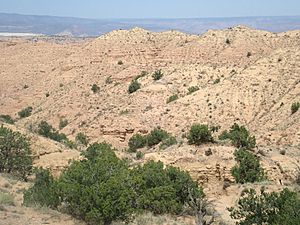Arroyo Ojito Formation facts for kids
Quick facts for kids Arroyo Ojito FormationStratigraphic range: Late Miocene, 8.1–6.8Ma |
|
|---|---|

Arroyo Ojito Formation at its type location northwest of Albuquerque, New Mexico, USA
|
|
| Type | Formation |
| Unit of | Santa Fe Group |
| Sub-units | Navajo Draw Member, Loma Barbon Member, Picuda Peak Member |
| Underlies | Ceja Formation |
| Overlies | Cerro Conejo Formation |
| Thickness | 500 meters (1,600 ft) |
| Lithology | |
| Primary | Sandstone |
| Other | Mudstone, conglomerate |
| Location | |
| Coordinates | 35°25′40″N 106°47′09″W / 35.4277°N 106.7858°W |
| Region | New Mexico |
| Country | United States |
| Type section | |
| Named for | Arroyo Ojito |
| Named by | Connell, Koning, and Cather |
| Year defined | 1999 |
The Arroyo Ojito Formation is a rock layer found near Albuquerque, New Mexico. It formed during the Late Miocene epoch, about 8.1 to 6.8 million years ago. This formation is made up of different types of rock, like sandstone, mudstone, and conglomerate. It tells us about ancient streams and rivers that once flowed in this area.
Contents
What is the Arroyo Ojito Formation?
The Arroyo Ojito Formation is made of sediments (bits of rock, sand, and mud) that were carried by streams. These streams flowed from the Sierra Nacimiento, San Juan Basin, and southeastern Colorado Plateau. The rocks are mostly sandstone, mudstone, and conglomerate.
The upper parts of the formation have coarser (bigger) bits of rock. This formation sits on top of the Cerro Conejo Formation. It is covered by the Ceja Formation. The Arroyo Ojito Formation is very thick, nearly 500 meters (1,600 ft) deep in some places.
Layers of the Formation
The Arroyo Ojito Formation is split into three main layers, called Members. These are the Navajo Draw, Loma Barbon, and Picuda Peak Members. They are listed from oldest (bottom) to youngest (top).
The Navajo Draw Member is mostly pale brown or yellow sandstone. It also has some layers of conglomerate and mudstone. These rocks were laid down by many rivers flowing towards the southeast.
This layer contains a type of volcanic rock called basalt. Scientists used a method called Ar-Ar dating to find its age. It is about 8.11 million years old. There is also an old volcano vent (Cerro Colorado) in the Rio Puerco valley. Its base is within this member and is about 7.1 million years old.
Loma Barbon Member
The Loma Barbon Member is similar to the Navajo Draw Member. However, its rocks are not as well sorted, meaning the rock bits are more mixed in size. It also has occasional layers of mudstone.
This layer contains volcanic ash, called tephra. This ash is between 6.8 and 7.1 million years old. This age is similar to the Peralta Tuff Member, which is part of the Bearhead Rhyolite. Because the ages are so similar, scientists think these two members might mix together in some areas.
Picuda Peak Member
The Picuda Peak Member is mostly reddish sandy conglomerate and sandstone. It includes some rock layers that were once thought to be part of the Ceja Formation. But now we know they are older.
This member is named after the conglomerate rocks found near Picuda Peak. Its thickness can vary from 10–50 meters (33–164 ft). This layer has coarser rocks than the Loma Barbon Member below it. As you move east, the contact between these layers becomes more uneven.
How Scientists Studied It
Scientists first described the Arroyo Ojito Formation in 1999. It was named by Connell and his team. They named it after the exposures (places where the rock layers are visible) along Arroyo Ojito, northwest of Albuquerque. This area is known as its type locality.
At first, this formation included all the rock layers in the northwest Albuquerque Basin that were younger than the Zia Formation. Later, scientists suggested some changes. For example, the Cerro Conejo Member was moved from the Zia Formation to the Arroyo Ojito. This was because there was a big gap in time (about 1 to 1.6 million years) between the Cerro Conejo and the rest of the Zia Formation.
In 2007, some scientists thought the name "Arroyo Ojito Formation" should not be used anymore. They felt the name was being used in confusing ways. Also, the formation crossed a major uneven surface in the rocks called the Rincones paleosurface. They suggested making the Ceja Member its own formation. The other parts of the Arroyo Ojito were moved into an informal "Middle Red" formation.
However, in 2008, Connell agreed to some changes but kept the Arroyo Ojito name. He agreed to make the Ceja Formation and the Cerro Conejo Formation separate formations. He kept the middle layers as the Arroyo Ojito Formation. He then divided it into the Navajo Draw, Loma Barbon, and Picuda Peak Members, as we know them today.

